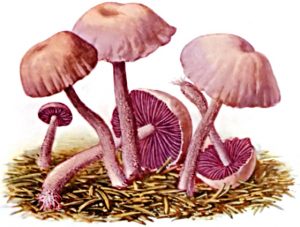Starvation and Thirst

Characters might find themselves without food or water and with no means to obtain them. In normal climates, Medium characters need at least a gallon of fluids and about a pound of decent food per day to avoid starvation. (Small characters need half as much.) In very hot climates, characters need two or three times as much water to avoid dehydration.
A character can go without water for 1 day plus a number of hours equal to his Constitution score. After this time, the character must make a Constitution check each hour (DC 10, +1 for each previous check) or take 1d6 points of nonlethal damage. Characters that take an amount of nonlethal damage equal to their total hit points begin to take lethal damage instead.
A character can go without food for 3 days, in growing discomfort. After this time, the character must make a Constitution check each day (DC 10, +1 for each previous check) or take 1d6 points of nonlethal damage.
Characters that take an amount of nonlethal damage equal to their total hit points begin to take lethal damage instead.
Characters who have taken nonlethal damage from lack of food or water are fatigued. Nonlethal damage from thirst or starvation cannot be recovered until the character gets food or water, as needed-not even magic that restores hit points heals this damage.
Finding
See also: Survival Skill
To find food and water for one person requires a Survival skill check DC 10. Enough food and water can be found for one additional person for every 2 points by which the Survival check result exceeds 10. The Survival skill information does not discuss risks of poisonous food or tainted water but such information as included in “Pathfinder Chronicles: Heart of the Jungle.” See below for chances of finding such hazards while hunting or foraging.
Poisonous Food

If a player is brave or naive enough to eat a plant or animal she’s unfamiliar with or is maneuvered into doing so by well-meaning or mischievous locals you may want to roll on the following table to determine whether or not the item is poisonous. The effects listed below may either represent actual poison or simply compounds travelers have not properly adapted to.
| Poisonous Food Effects | |||||
| Roll | Fort DC | Onset | Frequency | Effect | Cure |
| 1-50 | – | – | – | No effect | – |
| 50-75 | 15 | 5 min. | 1/10 min. | Nauseated | 1 Save |
| 76-85 | 12 | 10 min. | 1/min. for 3 min. | 1d6 hp | 2 Saves |
| 86-90 | 14 | 1 min. | 1/min. for 4 min. | 1 Strength, 1 Dexterity | 1 Save |
| 91-96 | 15 | 10 min. | 1/day | 1d2 Strength, 1d3 Constitution | 1 Save |
| 97-100 | – | 17 | 1/rd. for 7 rds. | 1d3 Constitution | 2 Saves |
With a DC 15 Knowledge (nature) or Survival check, a character can use smell, color, and other signs to tell if a potential food is likely to be poisonous, and a DC 20 check is usually enough to predict the severity of the poison effect. Also, an alchemist with access to the proper reagents may preserve the effects with a Craft (alchemy) check equal to 5 + the DC of the poison.
In addition to ingested poisons, there are also a fair number of contact poisons in the wild. Most notable are the poisonous frogs that inhabit jungles. Fortunately, most plants and animals that are poisonous to the touch are brightly colored and easy to pick out (requiring a DC 12 Survival or Knowledge (nature) check to recognize them as poisonous). If a character does touch one of these brightly colored objects, use either the 86-90 or 91-96 result on Table: Poisonous Food Effects above.
Tainted
Tainted water poses an attractive danger to a thirsty traveler. A character can make a DC 10 Survival check to tell fresh water from tainted water. Most trackers know that still water holds the greatest potential for contamination, while fast-moving streams and headwaters are more likely to be fresh. A purify food and drink spell, of course, removes all doubt, and create water renders the question moot. Canny adventurers pack clean bowls or canteens with which to carry magically purified or created water and boil any water they’re forced to harvest from lakes or rivers (effectively eliminating the threat of disease). Tainted water can have any number of causes, from dangerous local plants leaching poison into the water, to a battleground or dung heap upstream, or even a simple animal corpse decaying and putrefying at the water’s edge.
Source:
If a character drinks tainted water, she must make a DC 12 Fortitude save or contract Filth fever. The amount of water ingested does not modify the save or the severity of the disease in any way, as a thimbleful of tainted water can have the same effect as a bucketful. At your discretion, you can replace the standard Filth fever with a different disease (such as dysentery.)
Wading through tainted water can also communicate Filth fever, as tiny drops of the water get on the character’s hands, clothes, and face and can later be transferred to the mouth, nose, or eyes as the character moves about. It is more difficult to contract a disease in this way, though. When wading or swimming through tainted water, a character receives a +2 circumstance bonus on her save to resist contracting Filth fever.

 Buy me a coffee
Buy me a coffee